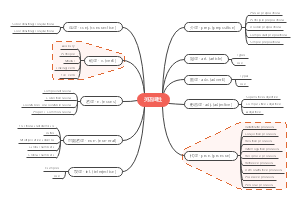导图社区 Chapter2 The sounds of language
- 24
- 0
- 0
- 举报
Chapter2 The sounds of language
这是一个关于Chapter2 The sounds of language的思维导图,包含Phonetics、Phonology。
编辑于2024-11-08 09:45:27- 语言学
- 相似推荐
- 大纲
The sounds of language
Phonetics
Definition: The study of the speech sounds that occour in all human languages is called phonetics.
Sounds production
airticulatory phonetics(production)
acoustic phonetic(transmission)
auditory phonetics(perception)
Speech organs
Oral cavity(air passage within the mouth&the throat)
upper/lower lip,upper/lower teeth,alveolar ridge,hard palate,soft palate(velum),uvula,tongue,pharynx,vocal cards,glootls.
nasal cavity(air passage within and behind the nose)
Voiceless & Voiced(声带是否振动)
Voiceless:vocal cords are apart.
Voiced:vocal cords are close together.
Nasal & Oral Sounds(软腭是否抬起)
Nasal sounds:Soft palate is raised.
Oral sounds:Soft palate is lowered.
Vowels & Consonants
Vowels: Sounds don't have obstruction to the flow of air passes from the larynx to the lips.
Consonants: Sounds produced by obstructing the flow of air in the vocal tract.
Classification of English speech sounds
English Consonants
According to the place of articulation:
Bilabials:upper and lower lips(b,p,m,w)4
Labiodentals:upper teeth and lower lips(f,v)2
Dentals/interdentals:the lip of the tongue between the upper and lower teeth(θ,δ)2
Alveolars:(t,d,s,z,n,l,r)7
Palatals:back of the tongue at the hard palate(5)
Velars:back of the tongue against the soft palate or velum(k,g,η)3
Glottal:two pieces of vocal cords(h)1
According to the manner of articulation:
Stops/plosives:complete stopping of the airstream + letting it go abruptly(p,b,t,d,k,g)6
Fricatives:stop the airstream,having the air push through the narrow opening in the mouth with friction(f,v,z,s,θ,h,δ)9
Affricates:stop the airstream + slowly releasing it with friction 2
Liquids:some obstruction + no real friction(l,r)2
Nasal:the velum is lower + airstream is flow out through the nose(m,n,η)3
Glides/semi-vowels:The tongue moves rapidly in a gliding fashion either towards or away from a neighboring vowel(j,w)
English vowels
the highest part of the tongue
front vowels 6
central vowels 3
back vowels 5
lip-rounding
rounded vowels— back vowels 4
unrounded vowels
frount vowels 6
central vowels 3
back vowels 1
opening degree
open 4
semi-open 6
close 4
Variations of sounds
Liaison: A phenomenon of the linking of words in speech ,in particular when the second word begins with a vowels.
4 types
Consonants+ vowels
R+vowels
the same consonants
vowels+ vowels
Elision: is the loss of a sound or sounds in speech.
when
rapid or casual speech
complex consonant clusters,ustressed syllables or syntactactically unstressed words.
4 types
爆破音 /b/- /p/ /d/-/t/ /g/-/k/
爆破音+辅音/半元音,爆破音不发音
爆破音在句尾,不发音
爆破音+爆破音+辅音/半元音,两个爆破音均不发音
摩擦音+摩擦音,只读后面一个,前音省略
辅音+/h/,/h/不发音
/v/+辅音
/v/+辅音,/v/不发音
/v/+/w/,/v/不发音
Assimilation:sounds belonging to one words or one syllable can cause changes in sounds belonging to neighboring words or syllables
2 types
Progressive assimilation(eg:books,dogs)
Regressive assimilation(eg:impossible,intolerant)
Phonology
Definition:is the description of the systems and patterns of speech sounds in a language.
Phonemes: the phonological units of language.(48 in English)
the smallest unit of sound in a language.
It can distinguish or contrast words.
Minimal pairs & sets
Minimal pairs are pairs of words which differ from each other only by one sound in a same position.(eg:pin - pen)
Minimal set is a group of which differ from each other only by one sound.
Free variation
Two or more sounds occur in the same position without any apparent change of meaning,they are said to be in free variation.
形(sound)变义(meaning)也变
When the subtitution of one sound for another results in a difference in meaning,the two sounds represents two different phonemes.
形(sound)变义(meaning)不变
Sometimes the change of one sound into another does not produce a different word,but only a different pronunciation of the same word.
allophone:The variants of a phoneme are called allophones of the same phoneme.
The allophones of the same phoneme never occur in the same context.They are said to be in complementary distribution.
Distinctive features is a feature to distinguish one phoneme from another.
Syllables: these units are often longer than one sound and smaller than a whole word.
Open syllable does not have coda.(eg:me,up,no) Notice:only tense vowels (long vowels & dipthongs) can occur in open syllables.
Closed syllable have cada.(eg:up,cup)
(C(C(C)))V((((C)C)C)C)
Syllables and consonant clusters
Consonant clusters: a sequence of two or more consonants in one syllable.(eg:astray /V-CCCV)
3 Classification
initial cluster
final cluster
medial cluster
3 strict rules:
the first consonant must be /s/.
the second phoneme must be /p/ /t/ /k/ (voiceless stop)
the third consonant must be /l/ /r/ /w/ /j/ (liquid+ glide→ approximate)
Syllabification
1.找元音(去尾e,一个元音一个音节,元音相连听音定,加上头尾是整体)
2.辅音归属
一靠后,二分手,多个中间偏左右(eg:so/lid, un/der, um/brella)
组合字母算一个,常见组合要遵守(pr,pl,fr,cl,st,sk,scr,gr…)
词尾看e加音节,发音不发分两种
+er,est,ing等,第一个元音字母肯定发音的词尾时,常增加一个音节,并用词尾的辅音字母当音节头。
+s,es,d,ed时,若e需要发音间隔增加一个音节,反之不增加音节。
双字相连不连手 (eg:x /ks/ —CC)
听声验证最后头,解释意外不发愁(th/ph/ng—C)mo/noph/thong CV-CVC-CVC
Suprasegmentals
Sound contrasts that extend over several segments(phonemes) and such contrasts are called suprasements.
Such as: stress,tone,intonation,pitch,length,volume,liaison,etc.
Stress points
word stress: stress location indicates word class.
noun. & verb.一般名词重音在第一个音,动词在第二个
adjective & verb 一般形容词重音在第一个音,动词在第二个
word stress indicates grammatical categories. compounds & noun phrases.
Intonation
functions of intonation:
Grammatical function
Attitudinal function
Accentual function









